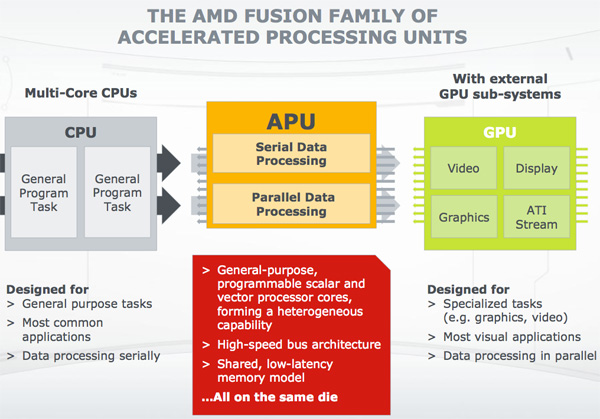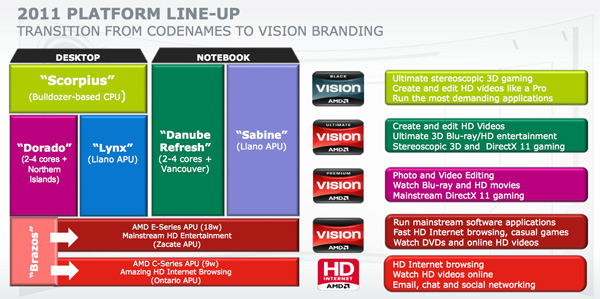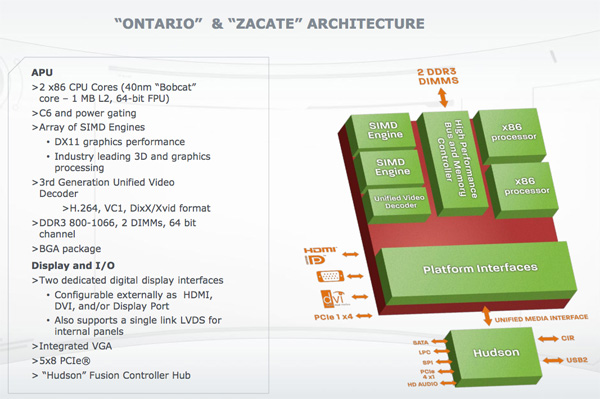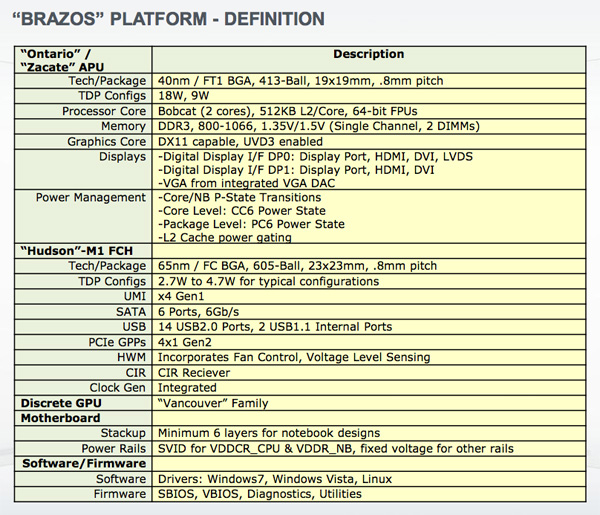Previewing AMD's Brazos, Part 1: More Details on Zacate/Ontario and Fusion
by Anand Lal Shimpi on November 9, 2010 1:09 AM ESTMeet the Brazos
The platform is called Brazos. Brazos encompasses two chips: a Zacate or Ontario APU (Accelerated Processing Unit) and the Hudson Fusion Controller Hub (FCH). This is the whole reason AMD bought ATI, Zacate and Ontario are its first CPU-GPU hybrids.
While AMD is primarily targeting the netbook/ultraportable and notebook markets with Ontario and Zacate (respectively), we’ll also see nettops/desktops and mini-ITX motherboards based on Brazos. This may be the first time we see real competition to NVIDIA’s ION platform.

AMD's Zacate APU, 19mm x 19mm package, 413 balls, 75mm^2 die
Both APUs are built from the same die. Zacate and Ontario are physically identical, they just run at different clock speeds. The 40nm die is manufactured at TSMC and measures 75mm^2. The chip is very cheap to package as well. The BGA package only has 413 balls. As one AMDer put it, these chips are designed to be stamped out as quickly and as cheaply as possible.
Both are available in single and dual core versions, although the single core variant is just a dual-core chip with one core disabled to hit various market segments. Core unlocking is apparently possible, but unexpected given the target for these platforms and the amount of effort OEMs would have to go to in order to enable it.
The CPU cores are based on AMD’s first truly low power client architecture, codenamed Bobcat. We’ve discussed Bobcat in great length already, but at a high level it looks a lot like an out-of-order Atom processor without Hyper Threading. The fundamental architecture advantage should give Bobcat the performance advantage over Atom, at least at identical clock speeds.
The GPU is based on AMD’s 5000 series architecture (Evergreen) and features 80 shader cores and AMD’s new UVD3 decode engine.
The SKUs
At launch you’ll see four SKUs, the combinations and specs are listed below:
| AMD Brazos Lineup | ||||||||
| APU Model | Number of Bobcat Cores | CPU Clock Speed | GPU | Number of GPU Cores | GPU Clock Speed | TDP | ||
| AMD E-350 | 2 | 1.6GHz | Radeon HD 6310 | 80 | 500MHz | 18W | ||
| AMD E-240 | 1 | 1.5GHz | Radeon HD 6310 | 80 | 500MHz | 18W | ||
| AMD C-50 | 2 | 1.0GHz | Radeon HD 6250 | 80 | 280MHz | 9W | ||
| AMD C-30 | 1 | 1.2GHz | Radeon HD 6250 | 80 | 280MHz | 9W | ||
Zacate takes the top two SKUs, while Ontario makes up the bottom two. The difference in TDP is entirely based on the clock speed of the CPU and GPU. And here is my concern. While a pair of Bobcats running at 1.6GHz are just awesome, drop the clock to 1.0GHz and I start getting concerned about performance. AMD didn’t let us test the C-50 but I’m curious to see what the margin of victory will be over Atom at that speed.
The GPU runs at 500MHz at the high end (Radeon HD 6310) and 280MHz at the low end (Radeon HD 6250). This paired with the single channel DDR3-800/1066 memory bus that has to be shared with the Bobcat cores means you should expect sub-5450 levels of performance out of these systems. Given their price point, that’s potentially not too bad. More enticing however is the fact that these APUs gain the benefit of the driver work AMD does on its discrete cards. Finally, game compatibility should be just as good on the low end as it is on the high end - assuming you meet the minimum specs for the title you’re running.
The lack of a brand for the CPU is a bit puzzling, but graphics are where it’s at these days.














106 Comments
View All Comments
khimera2000 - Wednesday, November 10, 2010 - link
and to match atoms Visual performance you will have to add in a nvidia card, which means on its own the atom missess out since smart users will want to use the power of there video cards to accelerate there daily tasks. Im already using it in microsoft office, the beta of IE8 and BETA firefox.Truth is intel does not have an image for fast video cards, and thats probably going to hurt the more in the long run then AMD's rep for making a good alternative.
Dark_Archonis - Wednesday, November 10, 2010 - link
Can you show me concrete proof that is is cheaper for AMD specifically to make a 75mm2 chip than it is for Intel to make an 87mm2 chip? We can assume its cheaper, but we have no concrete facts to back this up. The die size difference between 75 and 87 is negligible.nafhan - Tuesday, November 9, 2010 - link
The i3 is a bigger more complicated chip and package (MCM). The ULV i3's are in the same power envelope (18W), but by moving to an i3 you'd be trading GPU power and (at least to Intel) a higher price for additional CPU power. So, depending on the application, it might not be an upgrade.Also, with the Ontario vs. Atom, it's again going to be about the GPU. Probably very similar CPU power with much improved GPU capabilities.
Even if it's not a "home run", it's AMD leveraging their expertise and hitting Intel where they have a hole in their lineup.
Dark_Archonis - Tuesday, November 9, 2010 - link
Yes, until Intel covers that hole, and we are back to the usual state of things, AMD being behind Intel.Prosthetic Head - Tuesday, November 9, 2010 - link
Sorry, but you seem to be totally missing the point. The architectural differences mean that even at 1GHz bobcat is very likely to beat the 1.6GHz atom, even in most CPU bound workloads. Atom is an incredibly poorly performing 'in order' architecture.What you are saying is not much better than kids back in 2003 saying that "a 2.8GHz P4 Celeron MUST beat a 1.8GHz Athlon64 because its got over 1/3rd more GHz!!!"
The graphics system is also very important for the target market, a mediocre system can still feel very snappy in most likely usage scenarios provided it has a capable graphics subsystem. Now that many of the highly CPU bound media tasks (HD playback, transcoding, compression) are starting to make use of gpGPUs that will become even more important. Intel may POSSIBLY be able to get adequate 2d/3d acceleration working and integrated soon, but they are very far behind AMD here and have never marketed a CUDA/Stream/OpenCL capable chip and driver - thats a lot of catch-up work to do.
MFK - Tuesday, November 9, 2010 - link
Wish I could up-vote you like Reddit/Engadget.But yeah, basically what I was gonna say.
nitrousoxide - Tuesday, November 9, 2010 - link
P4 is running at almost 3 times the frequency of Athlon64...don't forget that its ALU runs at double frequency of the core (5.6GHz for a 2.8GHz P4)jollyjugg - Thursday, November 11, 2010 - link
Except what you are forgetting is that Bobcat is an out of order core and Atom is an inorder core. There is a lot of difference between these styles of architectures. What matters is not entirely the clock speed but also IPC. Only running a CPU at a higher frequency would be a brute force approach. Out of order processor has a much higher IPC than in order processor. Hence dont under estimate the CPU yet until you have seen Anand's promised performance numbers next week. Also however the CPU turns out, it is a real boon for people in the netbook segment to get a good graphics. People are frustrated with Intel's sucked up graphics and their over priced Atom based systems which hardly measure up to anything. It may not be something that turns the world upside down. But nevertheless it will be something that will be very welcome. We should also not forget that fusion is in their initial stages. It will get better with time.This is one thing Intel will take a long time catching up Graphics!!!!!! We may never know. Visual experience is something which is very powerful. It captures people's imagination. At an outset iphone and another phone may look the same. But its the performance that is the clincher. If this performs this is clinch for sure.
SteelCity1981 - Tuesday, November 9, 2010 - link
If it's based on the Evergreen architecture then why not just call it Radeon 5310 and 5250 series? Just confusing to call a Radeon GPU a 6310 and a 6250 when it's based on the Radeon 5 series. Especially considering there will be no new Radeon 6 series that will come out lower then the 6800 series.mino - Tuesday, November 9, 2010 - link
Well, 6800 series itself is heavily based on the 5000 series so ...It is all just branding. And, there WILL be more 6000 series parts. Llano being a confirmed one with at least Turks on the table as well.